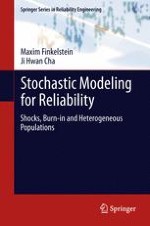2013 | OriginalPaper | Chapter
8. Burn-in for Heterogeneous Populations
Authors : Maxim Finkelstein, Ji Hwan Cha
Published in: Stochastic Modeling for Reliability
Publisher: Springer London
Activate our intelligent search to find suitable subject content or patents.
Select sections of text to find matching patents with Artificial Intelligence. powered by
Select sections of text to find additional relevant content using AI-assisted search. powered by
